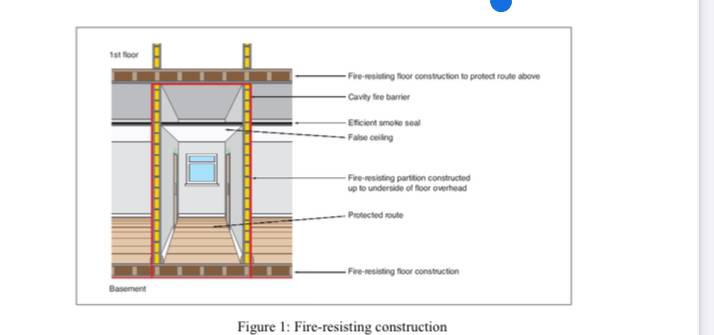CLASSIFICATION ACCORDING TO SHAPE FORMED BY SOFFIT/INTRADOS-: (I)FLAT ARCH (straight/ square / camber arch)-:
The extrados is horizontal and intrados is given a slight rise/camber of about 10 to 15mm/metre width of span so as to allow for slight settlement of it. The angle of skewback with horizontal is usually 60 degree. The depth of the arch is generally kept 3 or 4 courses of brick.
They are limited to span upto 1.5m unless strengthened by steel reinforcement.
(II)French / Dutch arch-: Similar in design with flat arch but differs in method of construction. This is not so sound in construction and so used for small inside opening or narrow spans only.
(III)Semi-circular arch-: The shape of the arch soffit is a semi-circle. The centre of the arch lies on the springing line.
(IV)Segmental arch-:The centre lies below the springing line. The bed joint of voussoirs radiate from the centre of arch. Depth may be 20cm, 30cm or multiple of half brick. Commonly used for arch.
(VI)Relieving arch-:Generallyconstructed over a wooden lintel or over a flat arch. It relieves the load of lintel or flat arch. The ends should be kept inside the solid wall. These days lintels restrict the use of relieving arch.
(VII)Pointed arch / Gatchic –It is formed intersection of curves at crown.Ther are 5 forms of these types of rches.i/e drop , equilateral , tudor, larcet and venetin.
(VIII)Venetin arch-: This one form of pointed arch which has a deper depth at crown other than arch springing line. It has 4 centres on springing line.
(IX) Floreutine arch-: Similar to venetian arch except that the intrados consist of a semi circular curve. It has three centres of springing line.
(X)Semi-circular arch-:It is formed by more than one centre usually 3 or 5 centres. (XI)Horse shoe arch-:It has a horse shoe like.
39 * Under revision
(XII)Stilted arch-: (a) 2 cusped arch -:This arch with 2 cups has centres at different level. This arch can be made in various forms and used for decorative purposes. This is not structurally efficient.
(c) Corbel arch-: It shape justifies its name it does not have arch action. Here each course is cantilevered out over the course below until the two sides meet. This is the oldest form of arch and not used in modern buildings.
CLASSIFICATION ACCORDING TO MATERIALS AND WORKMANSHIP INVOLVED IN CONSTRUCTION
Stone Arch- Rubble Arch-
*They are made of roughly dressed stones arranged and fitted into a definite arch shape by cement.
*All the stones used may not be of same size and so joints are thicker.
*They are relatively weak and so used for interior types of works.
*Their use is limited to span of 1 m.
*Up to a thickness of 40 cm stones are laid in one ring for full depth .
*for greater thickness than 40 cm two rings alternative courses of harder and stretcher.
Ashler Arch-
*Here strong are properly cut and dressed to true wedge shape (i. e voussoirs)
*Up to a depth of 60 cm, voussiors are made of full thickness of arch and are set in time (cement mortar)
*To known the no. and size of voussoirs and the key stove of arch, a full size arch is first set out on platform level and then sizes of stones are marked on platform after leaving a gap for joints. Templates are made for voussoirs and key stone of required shape, finally stones are out and dressed to wedge shapes of templates and arch is laid.
*They have good appearance and used for superior work.
40 * Under revision
*They have laid as heading and stretcher alternatively. When thickness is large, only the stone is made of full thickness of arch ring.
Brick Arch
Rough Brick Arch-
*Made with ordinary bricks, which are net wedges shaped and so joints are wider at extrados than the intrados.
*Generally they are constructed with half brick rings.
*They are cheap, poor in strength and appearance (suitable for consealed work)
Rough Cut Brick Arch-
*Ordinary bricks are roughly cut with a brick laying are to form wedge shaped
voussoirs. So joints are not appealing to eyes.
*They are considered not appealing to eyes and so unsuitable for exposed work *Used where facing brick work is finished with plaster coat.
Gauged Brick Arches
GAUGED BRICK-
*Bricks prepared to exact size and shape of voussoirs by cutting and dressing.
*Joints are very fine, thin and radially.
*Hard bricks can not be used due to difficulty in cutting to true wedge shape.
*So special bricks called rubber bricks are which can be cut and dressed easily to required shape.
*They are cut by saw and finished by rubbing with stone.
*To get thin and fine joint, lime purely is used to bind voussoirs.
41 * Under revision
PURPOSE MADE BRICKWORK-
*Superior type arch work to get fine and thickness. *putty lime is used for binding blocks.
Concrete Archery
Precast Concrete Block Archery-
*For small building opening, precast concrete blocks are used in cement mortar for arch construction.
*Concrete blocks for voussoirs, key blocks, skewbacks of required dimension is prepared from concrete mix and cured for 2-weeks. They are without steel reinforcement. They are successful in India for important building and bridges.
Monolithic Concrete Arches-
*They are constructed from cast in-situ concrete with / without reinforcement
depending on span and force frequently used for roofing of building, culvert and bridges.
*The construction for small spans and ordinary loads can be made with plane concrete. For large span RCC arches are used.
*For roofing arches, rise of 5 cm for every 30cm of span is allowed when lime concrete is used in arch work.
*Normally arch thickness greater than 15cm up to span of 3m and beyond this 4 cm should be added for each additional 30 cm more.
*Proper frame work and centering is provided to support fresh concrete during construction. Entire work should be kept for at least two weeks.
42 * Under revision
THRUST LINE
METHOD OF ANALYSIS OF MASONRY ARCHES
Static Approach-
The line containing all the points where the stress resulted at every section of the arch is called thrust line.
*The arch is safe when line of thrust is found to total inside the thickness of the masonry.A classic analysis method using this result involves the use of funicular polygon. This is a graphic method to construct the line of thrust for arches. If the arch is subjected only to vertical loads, then the horizontal component of thrust is constant throughout the whole arch. Nevertheless, the value of this component and its position at the start / end of the element are unknown. Thus the method must be iterative.
Maximum Thrust-
The maximum thrust case is thrust line, or zone of thrust, which takes the intrados once near the crown and the extrados near each springing. This pattern is the response the arch makes to abutments which squeeze together.
Linear Arch / Theoretical Arch / Line Of Thrust
When arch is subjected to given system of loading, the arch shape which follows the shape of the BM diagram for a beam of some span as that of the acrh and subjected to some loading as that in the arch is known as linear arch.
*The line of thrust of a portable arch is funicular polygon.
Eddy’s Theorem-
In an arch, BM at any point = horizontal thrust * vertical distance between line of thrust and centre line of arch
(BM at any section of an arch is proportional to the ordinate/intercept between the given arch and the linear arch.)
43 * Under revisio



No comments yet
Be the first to share your thoughts!